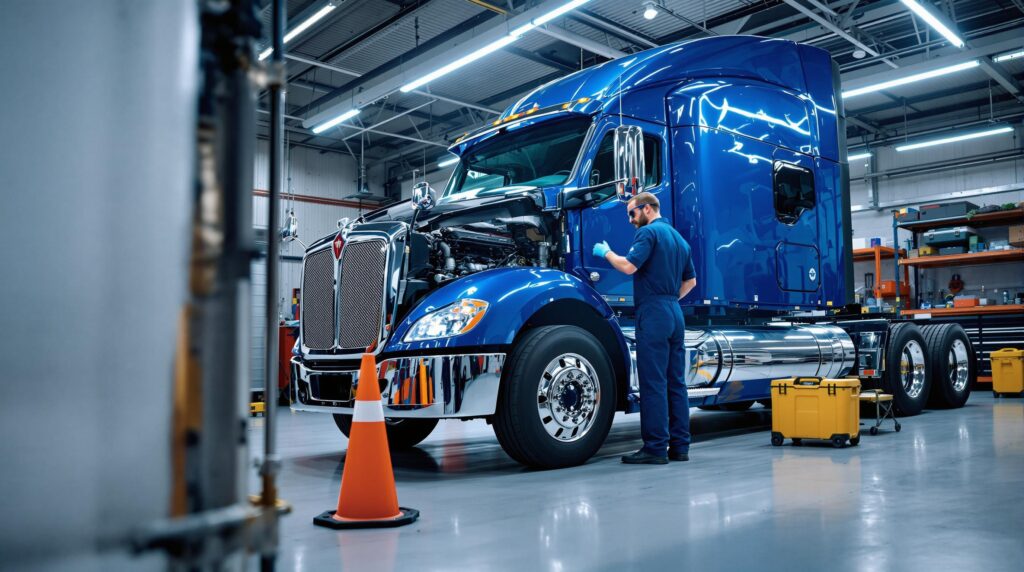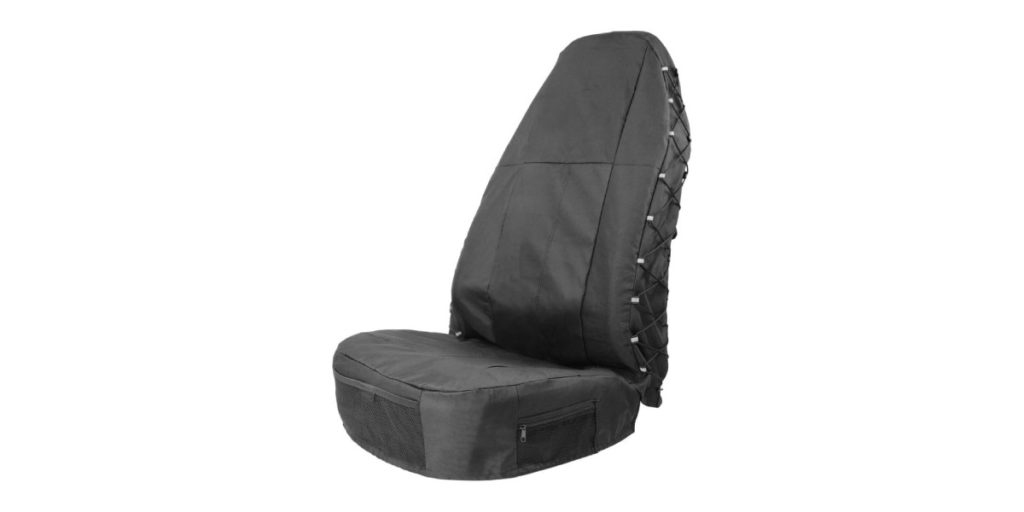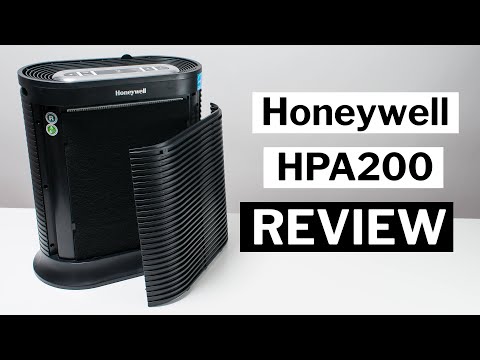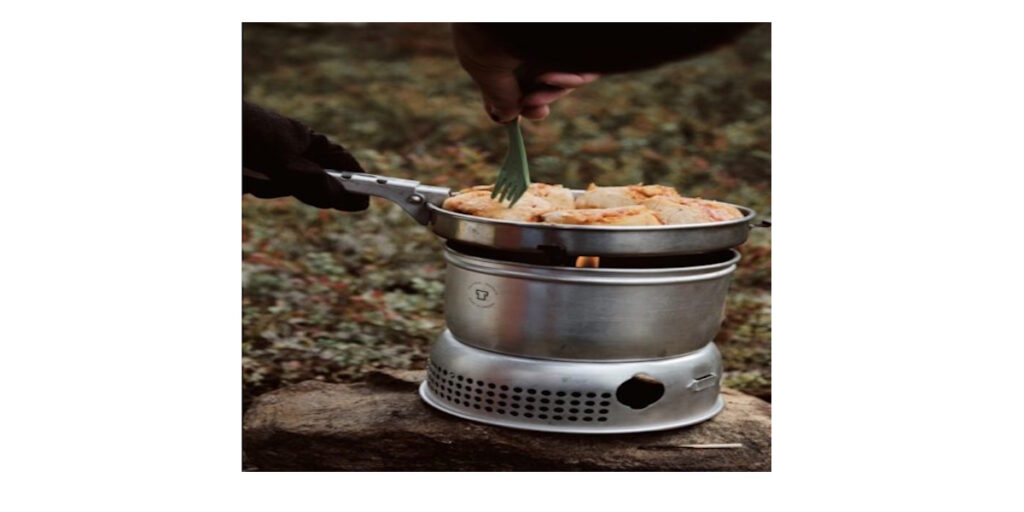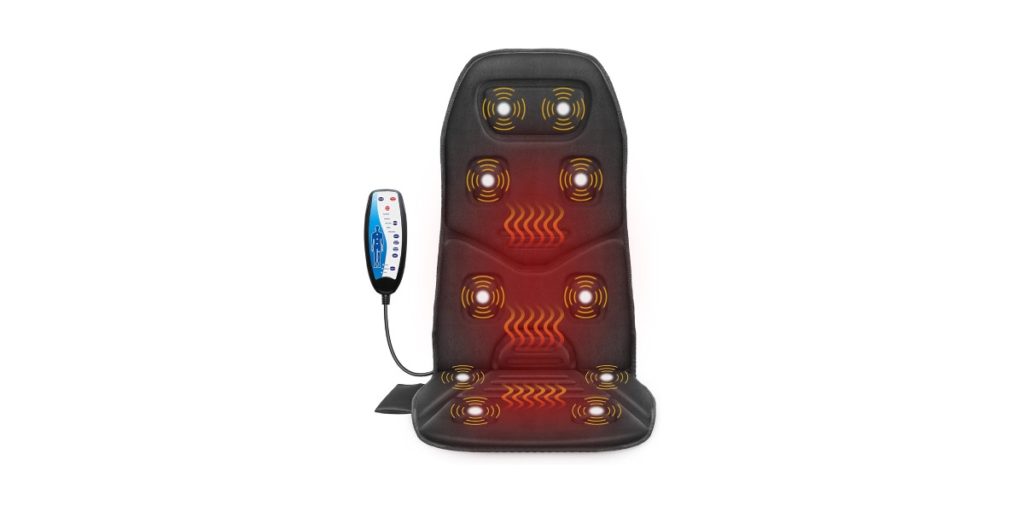Your truck is like a shield, protecting you and others on the road. When truck maintenance takes a backseat, that shield weakens, exposing you to potential dangers. Regular checks on critical systems like brakes and tires can prevent minor issues from becoming serious threats. So, what steps can you take today to guarantee your truck remains a reliable fortress against the unexpected?
Key Takeaways
- Regular brake inspections are essential to ensure safety and prevent minor issues from escalating into major problems.
- Maintaining proper tire pressure and tread depth enhances performance and significantly improves road safety.
- Routine checks of lights and signals ensure visibility and communication with other road users, crucial for safety.
- Keeping an emergency kit stocked with necessary supplies prepares you for unexpected situations on the road.
- Regular oil changes and transmission maintenance help prevent engine damage, ensuring reliable performance and safety.
Regular Brake Inspections
When it comes to maintaining your truck, regular brake inspections are essential to assure your safety on the road.
You need to check your brakes frequently to guarantee peak brake performance. A simple inspection can reveal any wear or damage that could compromise your ability to stop effectively.
It’s important to remember that even small issues can escalate into major problems if left unaddressed. By prioritizing brake safety, you not only protect yourself but also others on the road.
Don’t wait for warning signs; make inspections a routine part of your maintenance schedule. Whether you tackle it yourself or seek professional help, staying proactive about your brakes will keep your truck running smoothly and safely.
Be sure to check your brake pads and rotors for wear.
Don’t forget to replace brake fluid according to your truck’s manufacturer’s recommendations.
Keeping your brakes in top shape is essential for your safety on the road.
Regularly inspecting your brake pads and rotors is crucial for maintaining your truck’s safety.Take the time to conduct a thorough brake inspection.
Look for signs of wear, such as uneven surfaces, cracks, or thinning pads. Worn brake pads can greatly reduce brake performance, putting your safety at risk.
If you feel your truck pulling to one side when braking or hear unusual noises, don’t delay in checking the brakes. Keeping your brake system in ideal condition not only guarantees safer driving but also prolongs the life of your truck.
Replace brake fluid as recommended by your truck’s manufacturer
Brake fluid plays an essential role in your truck’s braking system, guaranteeing that the brakes respond effectively when you need them most. Over time, brake fluid can absorb moisture, leading to decreased performance and potential brake failure. To maintain ideal safety, replace the brake fluid as recommended by your truck’s manufacturer.
| Maintenance Task | Recommended Interval | Importance |
|---|---|---|
| Check Brake Fluid | Every 2 years | Prevents moisture buildup |
| Replace Brake Fluid | As per guidelines | Guarantees effective braking |
| Inspect Brake Lines | Annually | Prevents leaks |
| Monitor Brake Pads | Every 10,000 miles | Guarantees safety |
Check Tires and Tire Pressure
Maintaining ideal tire conditions is crucial for your truck’s performance and safety. Regularly check your tire pressure, making sure it meets the manufacturer’s specifications. Under-inflated tires can lead to uneven tread wear and reduced fuel efficiency.
It’s essential to inspect your tires for signs of damage and wear, as well. Look for bulges, cracks, or excessive tread wear that could compromise safety.
Don’t forget about tire alignment, too; misaligned tires can cause premature wear and affect handling. By keeping your tires properly inflated and aligned, you’ll enhance both performance and safety while extending the life of your tires.
Make tire checks a part of your routine maintenance to guarantee you’re always ready for the road ahead.
Tires are the only point of contact between your truck and the road.
Your tires play an essential role in your safety on the road, so regular inspections are a must.
Make sure to check the tread depth and replace tires when they’re worn down to 2/32 of an inch.
Don’t forget to monitor tire pressure monthly and rotate your tires every 5,000 to 7,500 miles for even wear.
Inspect tire tread regularly.
Regularly inspecting tire tread is essential for guaranteeing safe driving conditions. You should check the tread depth frequently and replace your tires when the dread depth reaches 4/32″ for the drives and 2/32″ for the steers
Worn tires can greatly impact your truck’s handling and braking, increasing the risk of accidents. To prolong tire life and improve performance, don’t forget to rotate your tires as recommended. This practice helps maintain even wear, extending their lifespan and enhancing safety.
Pay attention to any signs of uneven wear or damage, as these can indicate alignment or suspension issues. By prioritizing tire maintenance, you guarantee a safer driving experience for yourself and others on the road.
Check tire pressure monthly.
Checking tire pressure monthly is essential for safe driving. Properly inflated tires enhance fuel efficiency, improve handling, and reduce the risk of blowouts.
Here are some tire maintenance tips to help you stay on track:
- Use a reliable gauge: Invest in a quality tire pressure gauge for accurate readings.
- Know your manufacturer’s recommendations: Always refer to the vehicle’s manual for the correct pressure levels.
- Inspect regularly: Check for any visible damage or wear that could affect tire alignment importance.
Rotate your tires to promote even wear
To keep your truck’s performance at its best, rotating your tires every 5,000 to 7,500 miles is crucial for promoting even wear.
This practice helps guarantee that all tires maintain consistent tread depth, which enhances traction and stability on the road.
Regular tire rotation also complements proper tire alignment, reducing uneven wear and extending the lifespan of your tires.
Test Lights and Signals
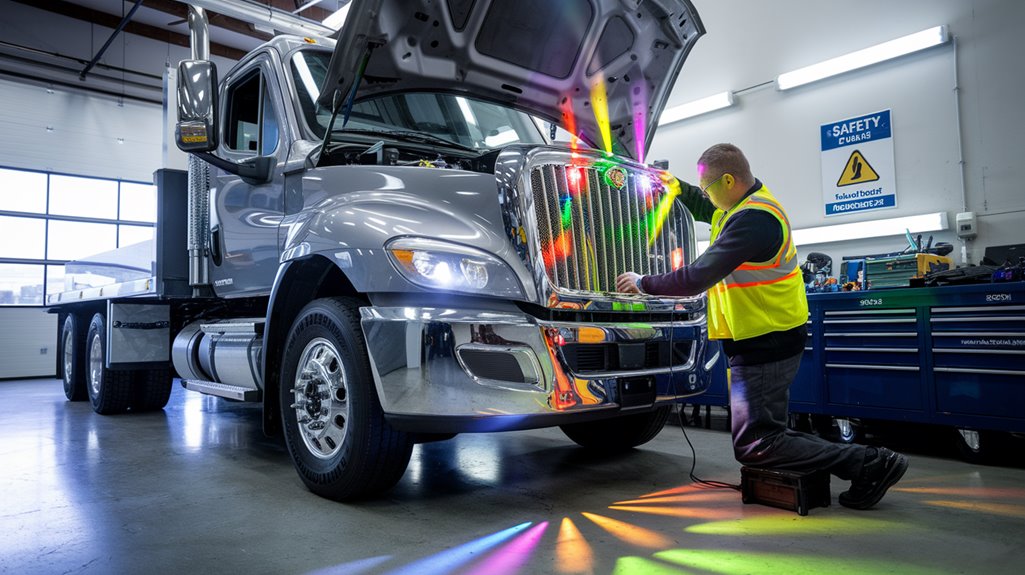
Testing lights and signals is essential for safe driving. Confirming proper light visibility and signal functionality can prevent accidents and keep you and others safe on the road.
Ensuring your lights and signals work properly is crucial for safe driving and accident prevention.
Here’s a quick checklist to help you stay on top of your truck’s lighting system:
- Headlights: Check both low and high beams for brightness and clarity.
- Taillights: Verify they illuminate brightly when you brake and are visible from a distance.
- Turn Signals: Test each signal to confirm they blink at the correct rate and brightness.
Faulty headlights, taillights, or turn signals can make driving dangerous.
When lights malfunction, driving becomes perilous, especially during nighttime or inclement weather. You need to guarantee that your headlights, taillights, and turn signals are in perfect working order to maintain ideal signal visibility.
Regularly check the alignment of your headlights; misaligned lights can blind oncoming drivers or fail to illuminate the road properly. Don’t forget to test your turn signals, as they’re essential for safe lane changes and turns.
If you notice any burnt-out bulbs, replace them immediately to avoid risking your safety and that of others. By staying proactive with your truck’s lighting system, you help create a safer driving environment for everyone on the road. Your vigilance can make all the difference in preventing accidents.
Keep Emergency Supplies On Hand
While guaranteeing your truck’s lights are in top shape is essential for safety, being prepared for unexpected situations is equally important.
Keeping an emergency kit stocked in your truck can make all the difference during a roadside crisis. Here are three essential items to include:
- First aid supplies: Bandages, antiseptics, and basic medications can help in case of minor injuries.
- Safety gear: Reflective vests, flares, and a flashlight guarantee you’re visible and safe while addressing any issues.
- Basic tools: A multipurpose tool, jumper cables, and a tire repair kit can help you tackle minor repairs on the spot.
Be prepared by keeping an emergency kit in your truck. Include items like
Even with the best maintenance, your truck can still break down unexpectedly.
That’s why it’s smart to keep an emergency kit handy. Make sure to include essentials like a first-aid kit, jumper cables, a flashlight with extra batteries, and a spare tire with a jack.
A first-aid kit
A well-stocked first-aid kit is essential for every truck driver, as unexpected breakdowns can occur at any time.
Having the right first aid essentials on hand not only helps you stay prepared but also guarantees your safety and that of others.
Here’s what you should include in your kit for effective emergency preparedness:
- Adhesive bandages: For minor cuts and scrapes.
- Antiseptic wipes: To clean wounds and prevent infection.
- Gauze pads and tape: For larger injuries that need extra protection.
Jumper cables
When your truck won’t start, having jumper cables on hand can be a lifesaver. Make certain you choose the right jumper cable gauge; thicker cables conduct electricity better, which means faster jumps.
Store your jumper cables properly to avoid tangles and damage. A dedicated spot in your emergency kit or under the seat works well.
Regularly check your cables for fraying or corrosion to verify they’re ready when you need them. Knowing how to use them can save you time and frustration.
If you’re not familiar with the process, take a moment to read the instructions or watch a tutorial. Being prepared with jumper cables can make all the difference on the road.
Stay safe out there!
A flashlight with extra batteries
Having a reliable flashlight with extra batteries in your truck can be a game-changer during unexpected breakdowns.
It’s crucial to make sure you’re prepared for emergencies, especially in low-light conditions.
Here are three key tips for flashlight maintenance and battery storage:
- Regularly check your flashlight: Make sure it works correctly and is free from corrosion.
- Store batteries properly: Keep them in a cool, dry place, and replace them periodically to avoid leakage.
- Choose high-quality batteries: Invest in long-lasting batteries designed for your flashlight to make sure you won’t be left in the dark.
A spare tire and jack
Keeping a spare tire and jack in your truck can save you from a frustrating situation on the road. Flat tires can happen unexpectedly, and having a spare tire ready to go guarantees you won’t be stranded.
Make certain you also carry a reliable jack, as it’s vital for safely lifting your truck to change the tire. Regular jack maintenance is important; check it periodically to verify it functions correctly when you need it most.
Additionally, familiarize yourself with the process of changing a tire, so you can act quickly and confidently. By taking these simple precautions, you’ll be better prepared for any breakdowns, allowing you to get back on the road in no time.
Enhancing Performance: Keep Your Truck Running Smoothly
To guarantee your truck performs at its best, regular maintenance is essential. By keeping your truck in top shape, you’ll enhance performance and save on costs.
Here are some fuel efficiency tips and engine tuning suggestions to take into account:
- **Regular *Oil Changes***: Clean oil guarantees your engine runs smoothly and efficiently. Change it according to the manufacturer’s recommendations.
- Tire Maintenance: Keep your tires properly inflated and rotated. This not only improves fuel efficiency but also extends tire life.
- Air Filter Replacement: A clean air filter improves engine performance and fuel economy. Check and replace it regularly.
Regular upkeep can prevent costly repairs and extend your truck’s lifespan.
When it comes to maintaining your truck, prioritizing performance can make a significant difference in its longevity and reliability.
To keep your truck running at its best, consider implementing some fuel efficiency tips. Regularly checking your tire pressure, for instance, can improve handling and reduce drag, leading to better mileage.
Also, think about performance upgrades like a cold air intake or a high-performance exhaust system; these can enhance engine efficiency and power.
Don’t forget to inspect your brakes and suspension regularly, as worn components can affect performance.
Change the Oil and Filters
Changing the oil and filters regularly is essential for maintaining your truck’s performance and longevity. Sticking to recommended oil change intervals not only keeps your engine running smoothly but also helps avoid major repairs down the line.
Here are some filter replacement tips to keep in mind:
- **Check your *owner’s manual***: Always follow the manufacturer’s guidelines for filter replacement schedules.
- Inspect filters regularly: Look for signs of dirt or damage, and replace them as needed to maintain efficiency.
- Use quality products: Opt for high-quality oil and filters to guarantee peak performance and protection for your engine.
Oil is the lifeblood of your truck’s engine, and regular oil changes are essential for smooth performance.
Changing your oil every 3,000 to 5,000 miles keeps your engine running smoothly.
Don’t forget to replace the oil filter during each change to prevent contamination.
Staying on top of these tasks can save you from costly repairs down the road.
Change the oil as recommended by your truck’s manufacturer
Regular oil changes are essential for keeping your truck’s engine running smoothly.
To maintain peak oil change frequency, aim to change the oil every 3,000 to 5,000 miles, or follow your truck’s manufacturer recommendations. This practice prevents engine wear and prolongs its life.
Here are three key reasons to stay on top of your oil changes:
- Prevents Engine Damage: Old oil loses its effectiveness, leading to potential engine failures.
- Enhances Fuel Efficiency: Clean oil reduces friction, improving your truck’s performance and fuel economy.
- Maintains Oil Filter Importance: Regular changes ensure that contaminants don’t build up and harm your engine.
Replace the oil filter during every oil change to avoid contamination
To keep your truck’s engine running efficiently, replacing the oil filter during every oil change is essential. The oil filter removes contaminants from the oil, ensuring that your engine stays clean and operates smoothly.
If you skip this step, you risk damaging your engine due to dirty oil circulating through it. Different oil filter types, such as spin-on or cartridge filters, may suit your truck’s specific needs, so make sure to choose the right one.
Aim for an oil change frequency of every 3,000 to 5,000 miles, or as your manufacturer recommends. By consistently replacing the oil filter, you’re not just prolonging your engine’s life; you’re also enhancing its performance and efficiency on the road.
Maintain the Transmission
Maintaining the transmission is essential for your truck’s performance and longevity. Regular checks can help you avoid costly transmission repairs down the line.
Here are three key steps to keep your transmission in top shape:
- Check Transmission Fluid: Regularly inspect the transmission fluid level and quality. Low or dirty fluid can lead to major issues.
- Change Transmission Fluid: Follow your truck manufacturer’s guidelines for changing the transmission fluid. Fresh fluid guarantees proper lubrication and cooling.
- **Watch for *Warning Signs***: Pay attention to unusual noises or slipping gears. Addressing these issues early can prevent extensive transmission repair.
Your truck’s transmission is responsible for transferring power from the engine to the wheels. To keep it in great shape
To keep your truck’s transmission running smoothly, you should check the transmission fluid regularly and top it off when necessary.
It’s also a good idea to schedule a transmission fluid flush every 30,000 to 60,000 miles, based on how you use your truck.
Staying on top of these tasks can help prevent costly repairs down the line.
Check the transmission fluid regularly and top it off as needed
Since your truck’s transmission plays a crucial role in transferring power from the engine to the wheels, checking the transmission fluid regularly is imperative for its longevity and performance.
Maintaining proper fluid levels not only protects your transmission but also enhances your truck’s overall efficiency.
Here are three simple steps to guarantee effective transmission maintenance:
- Check fluid levels: Use the dipstick to assess the fluid level and condition.
- Look for leaks: Inspect under your truck for any signs of leakage that may affect fluid levels.
- Top off as needed: If the fluid is low or discolored, add the appropriate type of fluid to maintain peak performance.
Schedule a transmission fluid flush depending on usage
A transmission fluid flush is essential for keeping your truck’s transmission in ideal condition, and scheduling it every 30,000 to 60,000 miles can make a significant difference.
Regular flushes help remove dirt and debris that can accumulate over time, ensuring smooth operation and extending the life of your transmission. Following this fluid replacement schedule is one of the top transmission maintenance tips you can adopt.
If you frequently haul heavy loads or drive in harsh conditions, consider leaning towards the shorter interval. Staying proactive with your transmission care means fewer costly repairs down the line.
Inspect Belts and Hoses
While you mightn’t think about them often, inspecting belts and hoses is essential for your truck’s performance and longevity.
Over time, you may notice issues like belt wear or hose leaks that can lead to costly repairs. Regular checks can save you from breakdowns.
Here’s what to focus on during your inspection:
- Check for cracks or fraying on belts, as these are signs of wear that could lead to failure.
- Inspect hoses for leaks or bulges, which can indicate deterioration that needs immediate attention.
- Ensure proper tension on belts to prevent slippage and maintain peak performance.
Belts and hoses are essential for your truck’s engine components to function properly.
check your belts regularly for any signs of fraying or cracking, as these can lead to serious engine issues.
Don’t forget to inspect your hoses for leaks or bulges, too. If you spot any damage, it’s essential to replace them promptly to keep your truck running smoothly.
Check belts for signs of wear, such as fraying or cracking, and replace them as needed
Inspecting your truck’s belts regularly is essential for ensuring ideal engine performance.
Over time, belts can show signs of wear that, if ignored, may lead to costly repairs or breakdowns.
Here’s how to conduct a thorough wear inspection:
- Fraying: Look for any frayed edges or loose threads, indicating that the belt is nearing its end.
- Cracking: Check for cracks or splits on the surface, which can compromise the belt’s integrity.
- Tension: Assess the tension of the belt; a loose belt can slip, while an overly tight one can cause damage.
If you notice any signs of wear, don’t delay in scheduling a belt replacement.
Keeping your belts in top shape is vital for a well-functioning engine.
Inspect hoses for leaks or bulges and replace any that show signs of damage
Regularly inspecting your truck’s hoses is crucial to prevent leaks and guarantee your engine operates smoothly.
Start by looking for any visible signs of damage, like bulges or cracks. Use leak detection techniques, such as applying soapy water to the hoses; bubbles will form if there’s a leak.
Don’t forget to check the connections and clamps for tightness, as loose fittings can lead to issues.
Follow these hose maintenance tips: replace any damaged hoses immediately to avoid engine complications and guarantee peak performance.
Make this inspection part of your routine maintenance schedule, and you’ll save yourself from costly repairs down the road.
Keeping your hoses in good condition is essential for your truck’s reliability and safety.
Protect the Battery
While you mightn’t think about it often, protecting your truck’s battery is essential for its overall performance and longevity.
Regular battery maintenance can save you from unexpected breakdowns and costly replacements. Here are three key steps to guarantee your battery stays in top shape:
- Clean Terminals: Remove any corrosion buildup on the terminals using a wire brush. This helps maintain a strong connection.
- Check Fluid Levels: Make sure the electrolyte levels are adequate. If they’re low, top them off with distilled water.
- Secure Connections: Ensure all connections are tight and free from rust. Loose or corroded connections can lead to power loss.
A healthy battery ensures your truck starts reliably and powers all its electrical systems.
To keep your truck’s battery in top shape, regularly check the terminals for corrosion and clean them if needed.
It’s also smart to test the battery’s charge before long trips or during extreme weather.
Check the battery terminals for corrosion and clean them if necessary
Since a reliable battery is essential for your truck’s performance, checking the battery terminals for corrosion should be a priority.
Regular battery maintenance helps guarantee your truck starts smoothly and its electrical systems function properly.
Follow these steps for effective corrosion prevention:
- Inspect the Terminals: Look for any white, ashy deposits on the terminals. This indicates corrosion.
- Disconnect the Battery: Always disconnect the battery cables before cleaning to avoid any electrical hazards.
- Clean the Terminals: Use a mixture of baking soda and water to scrub away corrosion. Rinse with clean water and dry thoroughly.
Test the battery’s charge periodically.
Regularly testing your battery’s charge is essential, especially before long trips or during extreme weather conditions. A healthy battery guarantees your truck starts reliably and powers all its electrical systems.
Follow these battery maintenance tips: start by using a multimeter to check the voltage; it should read around 12.6 volts when fully charged. If it’s lower, consider recharging or replacing the battery.
During extreme weather precautions, keep your battery clean and free from corrosion, as this can affect performance. Additionally, check connections to confirm they’re tight and secure.
Replace the battery as needed
Most truck batteries need replacement every 3 to 5 years, depending on usage and conditions. A healthy battery guarantees your truck starts reliably and powers all its electrical systems.
To maintain your battery and enhance its lifespan, follow these tips:
- Inspect regularly: Check for corrosion and loose connections to prevent future issues.
- Clean terminals: Keep battery terminals clean to guarantee peak performance and longevity.
- Test frequently: Monitor the battery’s charge, especially before long trips or in extreme weather.
Comfort Matters: Keeping Your Truck Enjoyable to Drive
While you might think of your truck primarily as a workhorse, guaranteeing it’s comfortable to drive can transform every journey into a more enjoyable experience.
Start with seat comfort; investing in quality seat cushions or ergonomic seats can make long drives far less taxing on your body. Adjusting the seat position to fit your frame also helps reduce fatigue.
Invest in quality seat cushions or ergonomic seats to enhance comfort and reduce fatigue during long drives.
Next, don’t overlook climate control. A well-functioning air conditioning and heating system keeps you comfortable, regardless of the weather. Regularly check the system to guarantee it operates efficiently.
Lastly, consider adding features like heated seats or adjustable lumbar support.
Maintaining your truck is not just about safety and performance—it’s also about ensuring a comfortable driving experience.
When it comes to maintaining your truck, focusing on comfort can greatly enhance your driving experience.
You deserve a space that feels good, especially during long hours on the road. Here are three ways to prioritize comfort:
- Ergonomic Seating: Invest in high-quality, ergonomic seats that provide support and reduce fatigue, allowing you to drive longer without discomfort.
- Climate Control: Verify your heating and air conditioning systems work efficiently to keep the cabin at a comfortable temperature, no matter the weather.
- Driver Entertainment: Upgrade your audio system or install a hands-free device to enjoy music or podcasts, making your drives enjoyable and less monotonous.
Keep the Cabin Clean
Keeping your truck’s cabin clean is essential for both comfort and hygiene. A well-organized cabin not only makes your driving experience more pleasant but also promotes safety. Regularly declutter your space and use storage solutions to keep everything in its place.
Here’s a quick guide to help you maintain cabin organization:
| Task | Frequency |
|---|---|
| Remove trash | Daily |
| Wipe surfaces | Weekly |
| Replace air fresheners | Monthly |
Don’t underestimate the power of air fresheners; they can make your cabin feel fresh and inviting. By taking the time to keep your cabin clean, you’ll enjoy a more comfortable and pleasant drive, making every journey a pleasure.
A clean cabin improves your overall driving experience. Make it a habit to
A clean cabin makes your truck feel more inviting and enjoyable to drive.
Make it a habit to vacuum the seats and floors regularly, wipe down surfaces, and use air fresheners to keep everything fresh.
You’ll notice the difference in both comfort and mood on the road.
Vacuum the seats and floors regularly
Regularly vacuuming the seats and floors of your truck is essential for maintaining a clean and pleasant cabin.
Not only does it enhance your driving experience, but it also promotes hygiene by removing dirt and allergens.
Make it a habit to include seat cleaning in your routine.
Here’s how to effectively tackle debris removal:
- Choose the Right Vacuum: Use a vacuum with attachments designed for upholstery and tight spaces.
- **Focus on *High-Traffic Areas***: Pay extra attention to spots where you frequently sit or place items.
- Schedule Regular Cleanings: Aim to vacuum at least once a week to keep the cabin fresh and inviting.
Wipe down surfaces like the dashboard, steering wheel, and windows
Vacuuming the seats and floors is just the beginning of maintaining a clean truck interior. To elevate your driving experience, make it a habit to wipe down surfaces like the dashboard, steering wheel, and windows regularly.
This dashboard maintenance not only keeps your truck looking sharp but also enhances visibility and safety. Dust and grime can accumulate quickly, making it harder to focus on the road.
For effective window cleaning, use a microfiber cloth and a suitable cleaner to avoid streaks. By taking a few minutes each week to care for these surfaces, you’ll guarantee a more comfortable and enjoyable ride.
Use air fresheners or cabin filters to keep the interior smelling fresh
Keeping your truck’s interior smelling fresh is just as important as maintaining its cleanliness. A pleasant scent can greatly enhance your driving experience.
To achieve cabin cleanliness and freshness, consider these tips:
- **Use *Air Fresheners***: Choose a scent you enjoy, whether it’s a spray, gel, or hanging freshener. Refresh regularly to keep odors at bay.
- **Install *Cabin Filters***: These filters help trap dust, pollen, and unpleasant smells. Replace them as recommended to guarantee peak performance.
- Regular Cleaning: Vacuum the seats and carpets, and wipe down surfaces to avoid buildup of dirt and grime that can cause odors.
Maintain the Air Conditioning and Heating Systems
While you mightn’t think about it often, maintaining your truck’s air conditioning and heating systems is vital for both comfort and safety. A well-functioning system not only keeps the cabin temperature pleasant but also helps you stay focused on the road.
Regular air filter maintenance is important; a clean filter guarantees that air flows freely and reduces the likelihood of system failure. Check it regularly and replace it as needed.
Additionally, pay attention to the refrigerant levels in your A/C. Low levels can lead to inefficient cooling, making your driving experience uncomfortable.
Your truck’s HVAC system is crucial for comfort, keep it in good condition
Your truck’s HVAC system plays an essential role in keeping you comfortable during extreme weather.
To guarantee it’s running smoothly, make sure to check and replace the cabin air filters as needed, recharge the air conditioning if it’s not cooling well, and inspect the heating system before the winter chill sets in.
Staying on top of these maintenance tasks will help you enjoy a pleasant ride year-round.
Check and replace cabin air filters as recommended
Regularly checking and replacing your cabin air filter is essential for maintaining a comfortable environment inside your truck.
A clean filter not only enhances cabin cleanliness but also improves filter efficiency, ensuring you breathe in fresh air during your journeys.
Follow these steps to keep your cabin air filter in top shape:
- Check the cabin air filter every 12,000 to 15,000 miles or as recommended in your truck’s manual.
- Replace it if you notice reduced airflow or unpleasant odors.
- Inspect the filter more frequently in dusty or polluted environments.
Recharge the air conditioning system if it’s not cooling effectively
When the air conditioning system in your truck isn’t cooling effectively, it can quickly turn a comfortable drive into an uncomfortable experience, especially in extreme weather.
Start with basic air conditioning troubleshooting to identify the issue. Check the refrigerant levels; low refrigerant can greatly reduce cooling performance. If they’re low, it’s time to recharge the system. You can do this yourself with a recharge kit or take it to a professional.
Make sure to inspect for leaks as well, since they can lead to ongoing issues. Regularly maintaining your A/C not only enhances comfort but also prolongs the life of the system.
Stay cool on the road by ensuring your air conditioning is always in top shape.
Inspect the heating system before winter to ensure it’s working properly
As winter approaches, verifying your truck’s heating system is in good working order becomes essential for a comfortable ride.
Proper heating efficiency not only keeps you warm but also contributes to winter preparedness.
Here’s what you should check:
- **Inspect the *heater core***: Make sure there are no leaks and that it’s delivering sufficient heat.
- Test the thermostat: Confirm it opens and closes at the correct temperatures to maintain peak heating performance.
- Check the blower motor: Confirm it operates at all speeds and circulates warm air efficiently throughout the cabin.
Upgrade Seating and Accessories
Upgrading your truck’s seating and accessories not only enhances comfort but also boosts functionality for daily tasks. Investing in seat upgrades can make long drives more enjoyable, providing better lumbar support and cushioning. You’ll notice a significant difference during those long hauls.
Additionally, consider accessory enhancements that suit your lifestyle. Adding cup holders, storage solutions, or even a better sound system can transform your driving experience.
Whether you’re hauling equipment or taking a road trip, these improvements make your truck more practical and enjoyable.
You’ll appreciate how these upgrades streamline your day-to-day activities, allowing you to focus on the road ahead. Prioritizing comfort and functionality is key to maintaining a safe and efficient driving environment.
Frequently Asked Questions
How Often Should I Perform a Complete Truck Maintenance Check?
You should perform a complete truck maintenance check based on your maintenance schedule, ideally after every long haul. Regular inspection frequency helps catch issues early and keeps your truck running smoothly.
What Are Common Signs My Truck Needs Immediate Maintenance?
If you notice an engine warning light, unusual noises, or excessive tire wear, it’s time for immediate maintenance. Ignoring these signs can lead to bigger problems, so don’t wait—get your truck checked right away.
Can I Perform Maintenance Myself, or Should I Hire a Professional?
If you notice your truck’s brakes squeaking, you might consider DIY maintenance for simple tasks like changing brake pads. However, for complex issues, hiring professional services guarantees thorough care and safety you can’t compromise on.
How Can Weather Affect My Truck’s Maintenance Needs?
Weather impacts your truck’s maintenance needs considerably. You’ll need seasonal adjustments for tires, fluids, and battery performance. Cold temperatures can thicken oil, while heat may cause overheating—stay proactive to guarantee peak performance throughout the year.
What Should I Do in Case of a Breakdown?
In case of a breakdown, stay calm and assess the situation. Check your emergency supplies, like flares and a first aid kit. Call for assistance and guarantee you’re visible to other drivers for safety.
Final Thoughts
By prioritizing safety in your truck maintenance routine, you’re not just protecting yourself; you’re protecting everyone on the road. Regular brake checks keep you stopping smoothly, proper tire care keeps you gripping the asphalt, and functioning lights guarantee you’re seen. Staying proactive with HVAC maintenance keeps you comfortable, while upgraded seating enhances your driving experience. Embrace these practices, and you’ll drive with confidence, knowing you’ve done everything possible to guarantee safety for yourself and others.

